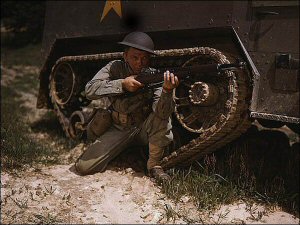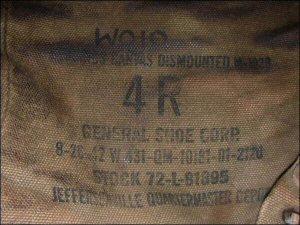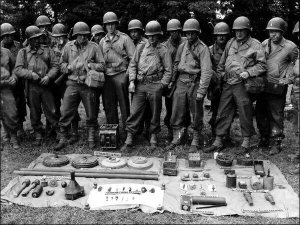The M-1938 Legging - An Introduction
Published: Fall 2008
Author: Mike "Squirrely" Ellis
Background--
The side-lacing dismounted leggings were an attempt to replace the awkward puttee, itself a replacement for various leggings used prior to the Great War. It remains for debate as to whether or not leggings were a wise replacement, but it can be said that they do not catastrophically fail, should they be tied correctly, and that they are much easier to train fresh recruits to correctly don and maintain.
Prewar use of the m-1938 dismounted legging.
Original M1938 leggings came in sizes 1-4, 1 being the smallest, 4 being the largest. Most American males will be able to get by with a size 2 or 3 legging, but those with large calves will have to buy a reproduction. It is recommended you try on both size 2 and 3 before buying a pair – I myself wore a 3 for years, until I discovered that a 2 offered much more support, as well as longer wear due to a better fit. Each size also made use of a single letter suffix to denote height. For instance: 3R (size 3, regular height), 2L (size 2, long height), 2R (size 2, regular height), etc. This suffix has nothing to do with the circumference of the legging.
Early types were stamped directly onto the canvas. This would fade until illegible, causing re-issue problems.
Midwar, a small white tag was added with the size.
Leggings were sized based upon the distance around the wearer's calf, aka, the top of the legging. Which one are you?
1R - 15 Inches
2R - 16 Inches
3R - 17 Inches
4R - 18 Inches
Additionally, reproductions have been produced in the following supersizes:
5R - 19 Inches
6R - 20 Inches
Original Size 4R leggings - these are very hard to find.
Early leggings made use of 9 metal hooks to secure the laces. Second pattern leggings usually had 8. Some late war leggings feature 7 or less, as a further measure meant to conserve metal. Early pattern leggings featured brass hardware, later models switched to steel. There was no published regulation regarding how the soldier was to tie off the lace at the top.
Brass on top, steel hardware below.
Like many items, Leggings were impregnated to resist blistering agents. Millions upon countless millions of leggings were manufactured before, during, and after the war, and they are one of the few original items available to all reenactors at an affordable price. Leggings in unissued condition are still extremely common, and generally retail for double the price of a visibly used pair. Late pattern leggings are generally less encountered, though by no means rare.
US Army Engineers, behind a display of captured enemy ordnance - the dismounted legging is part of the uniform of the day.
95% of US Army leggings were, at some point, marked "Leggings, Canvas, Dismounted, M-1938". Unless the pair in question is highly faded, the absence of this marking is a strong indicator that you are not holding Army pattern leggings - both the Navy and Marine Corps also had their own specific patterns.
Background--
Correct Use
Lacing Methods
Putting Them On
Preparing
Step 1-2
Step 3-5
Step 6-9
Step 10
Step 11Different Ways to Wear Leggings--
Traditional
The High Roller
The Cut Down
No Leggings?
Leggings For DummiesReduced Eyelets
The Change to O.D. #7
Leggings, Dismounted, O.D.
Factory-made Cut Downs?
90th IDPG Research






